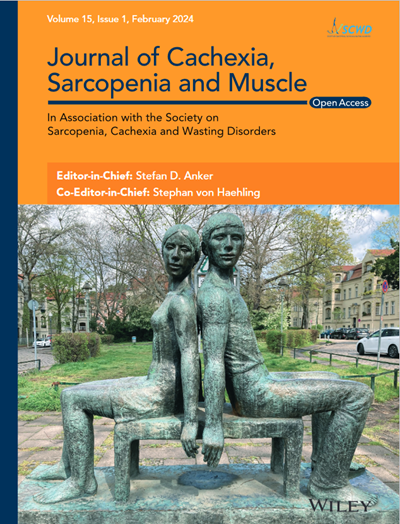Hand grip strength (HGS) is a widely used functional test for the assessment of strength and functional status in patients with cancer, in particular with cancer cachexia. The aim was to prospectively evaluate the prognostic value of HGS in patients with mostly advanced cancer with and without cachexia and to establish reference values for a European-based population.
In this prospective study, 333 patients with cancer (85% stage III/IV) and 65 healthy controls of similar age and sex were enrolled. None of the study participants had significant cardiovascular disease or active infection at baseline. Repetitive HGS assessment was performed using a hand dynamometer to measure the maximal HGS (kilograms). Presence of cancer cachexia was defined when patients had ≥5% weight loss within 6 months or when body mass index was <20.0 kg/m2 with ≥2% weight loss (Fearon's criteria). Cox proportional hazard analyses were performed to assess the relationship of maximal HGS to all-cause mortality and to determine cut-offs for HGS with the best predictive power. We also assessed associations with additional relevant clinical and functional outcome measures at baseline, including anthropometric measures, physical function (Karnofsky Performance Status and Eastern Cooperative of Oncology Group), physical activity (4-m gait speed test and 6-min walk test), patient-reported outcomes (EQ-5D-5L and Visual Analogue Scale appetite/pain) and nutrition status (Mini Nutritional Assessment).
The mean age was 60 ± 14 years; 163 (51%) were female, and 148 (44%) had cachexia at baseline. Patients with cancer showed 18% lower HGS than healthy controls (31.2 ± 11.9 vs. 37.9 ± 11.6 kg, P < 0.001). Patients with cancer cachexia had 16% lower HGS than those without cachexia (28.3 ± 10.1 vs. 33.6 ± 12.3 kg, P < 0.001). Patients with cancer were followed for a mean of 17 months (range 6–50), and 182 (55%) patients died during follow-up (2-year mortality rate 53%) (95% confidence interval 48–59%). Reduced maximal HGS was associated with increased mortality (per −5 kg; hazard ratio [HR] 1.19; 1.10–1.28; P < 0.0001; independently of age, sex, cancer stage, cancer entity and presence of cachexia). HGS was also a predictor of mortality in patients with cachexia (per −5 kg; HR 1.20; 1.08–1.33; P = 0.001) and without cachexia (per −5 kg; HR 1.18; 1.04–1.34; P = 0.010). The cut-off for maximal HGS with the best predictive power for poor survival was <25.1 kg for females (sensitivity 54%, specificity 63%) and <40.2 kg for males (sensitivity 69%, specificity 68%).
Reduced maximal HGS was associated with higher all-cause mortality, reduced overall functional status and decreased physical performance in patients with mostly advanced cancer. Similar results were found for patients with and without cancer cachexia.


